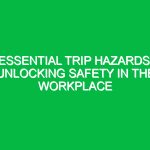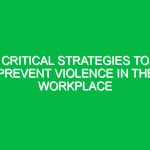Welcome and Purpose
Hello team! Today, we’re gathering for a toolbox talk focused on an often-overlooked but crucial aspect of our Health, Safety, and Environment (HSE) practices: Noise at Work and Home. Noise can significantly impact our health, productivity, and overall well-being. By understanding how to manage noise effectively at both work and home, we can create a safer and more pleasant environment for everyone.
Understanding Noise: What Is It?
Before diving deeper, let’s clarify what we mean by noise. Noise is defined as any unwanted or disruptive sound that can interfere with normal activities. This can include everything from machinery in the workplace to loud music at home. Recognizing what constitutes noise is the first step in managing it effectively.
The Importance of Managing Noise
Noise management isn’t just about comfort; it’s about health and Safety. Prolonged exposure to high noise levels can lead to a range of health issues, including:
- Hearing loss
- Increased stress levels
- Sleep disturbances
- Decreased productivity
- Impaired communication
By managing noise, we enhance not only our physical health but also our mental well-being and workplace efficiency.
Key Regulations and Standards
It’s essential to be aware of the regulations surrounding noise management. In many jurisdictions, there are specific guidelines and standards to protect workers from excessive noise exposure. For example, the Occupational Safety and Health Administration (OSHA) in the United States sets permissible noise exposure limits, which are typically 90 dBA over an 8-hour workday. Familiarizing ourselves with these regulations is vital, as non-compliance can lead to serious consequences, including legal actions and fines.
Identifying Noise Sources
To effectively manage noise, we must first identify the sources. Here are some common sources of noise at work:
- Machinery and equipment
- Power tools
- Vehicle traffic
- Employee conversations
At home, common noise sources may include:
- Household appliances (like vacuum cleaners)
- Entertainment systems
- Neighborhood activities
By identifying these sources, we can implement strategies to mitigate their impact.
Assessing Noise Levels
Once we identify noise sources, it’s crucial to assess their impact. This can be done using a sound level meter, which measures decibel levels. Sound levels are categorized as follows:
- Quiet office: 40-50 dBA
- Normal conversation: 60-70 dBA
- Heavy traffic: 80-90 dBA
- Chainsaw: 100-110 dBA
If we find ourselves frequently in environments exceeding 85 dBA, it’s time to take action to protect our hearing and overall well-being.
Best Practices for Managing Noise at Work
Now that we understand the impact of noise and how to assess it, let’s discuss some practical strategies for managing noise in the workplace:
1. Engineering Controls
Implementing engineering controls can significantly reduce noise levels. This includes:
- Installing sound barriers or dampening materials
- Using quieter machinery
- Maintaining equipment to reduce noise output
2. Administrative Controls
Administrative controls involve changing how we work. This can include:
- Limiting exposure time to noisy environments
- Implementing rotating shifts for noise-intensive tasks
- Creating quiet zones for focused work
3. Personal Protective Equipment (PPE)
When other measures are not enough, wearing appropriate PPE becomes essential. This includes:
- Earplugs
- Noise-canceling headphones
- Soundproof earmuffs
It’s crucial to ensure that everyone is trained on how to use these devices effectively.
Best Practices for Managing Noise at Home
Managing noise at home is just as important as at work, especially if you work remotely. Here are some tips:
1. Soundproofing
Consider soundproofing your home office by:
- Using heavy curtains or sound-absorbing panels
- Sealing gaps around windows and doors
- Adding carpets or rugs to reduce noise reflection
2. Creating a Quiet Space
Designate a quiet space at home for work or relaxation. This can help minimize distractions. Make sure everyone in the household understands the importance of keeping noise levels down during work hours.
3. Limiting Distractions
Be mindful of the noise generated by personal devices. For instance, keep your phone on silent during work hours and consider using headphones when listening to music or watching videos.
Real-Life Examples
Let’s look at a couple of real-life scenarios to illustrate the importance of managing noise:
Scenario 1: Construction Site
Imagine a construction site where heavy machinery operates continuously. Workers are exposed to high noise levels, leading to fatigue and decreased productivity. By implementing engineering controls, such as using quieter equipment and providing PPE, the site manager could significantly reduce noise exposure and enhance worker Safety.
Scenario 2: Home Office
Now, consider someone working from home with children playing nearby. The constant noise makes it challenging to focus. By creating a dedicated quiet space and setting boundaries with family members during work hours, the individual can improve their concentration and productivity.
Engaging Discussion
As we wrap up this toolbox talk, let’s open the floor for discussion. Here are a few questions to consider:
- What noise sources do you encounter regularly at work and home?
- Have you implemented any strategies to manage noise effectively? What worked for you?
- What further steps do you think we can take as a team to reduce noise levels?
Your insights are invaluable as we strive to create a safer and more productive environment.
Conclusion
In summary, managing Noise at Work and Home is vital for our health, safety, and productivity. By understanding the sources of noise, assessing levels, and employing effective management strategies, we can foster a better working environment. Thank you all for your attention and commitment to improving our Workplace Safety. Let’s work together to implement these practices and ensure a quieter, safer environment for everyone.


